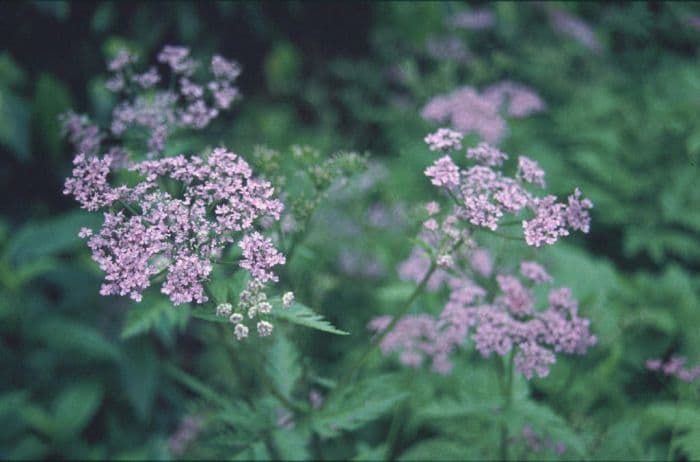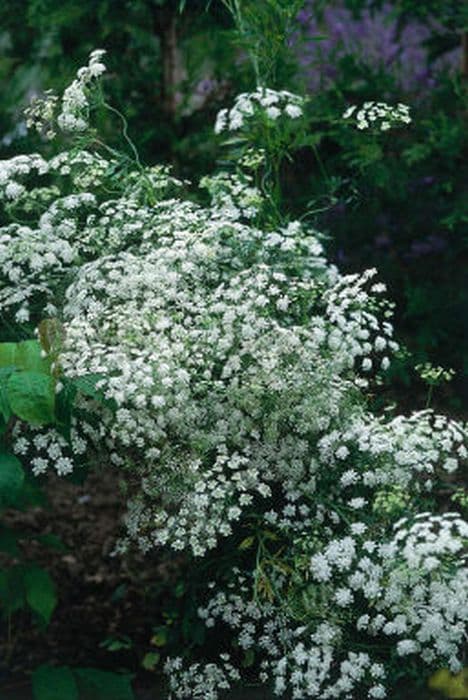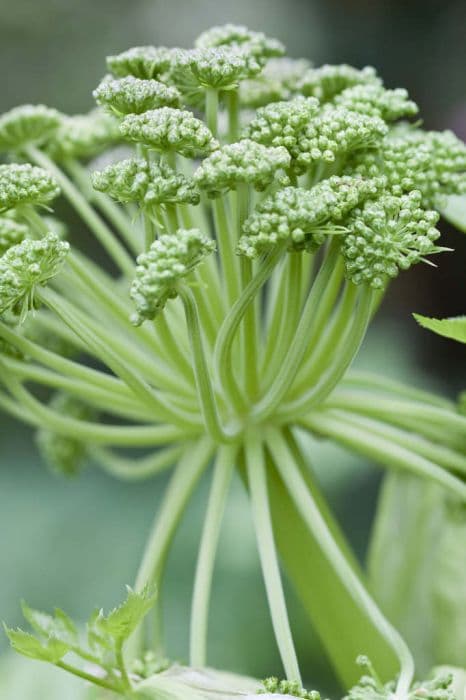Hairy Chervil Chaerophyllum hirsutum 'Roseum'

ABOUT
Chaerophyllum hirsutum 'Roseum', commonly known as Pink Chervil or Hairy Chervil, is a flowering plant that exhibits a delicate and attractive appearance. The leaves of this plant are softly textured, giving a sort of downy look. They are typically divided and fern-like in shape, contributing to the plant's overall feathery and light aspect. The foliage can have a lush, green color, adding to the fresh, airy feel of the plant. The most noteworthy feature of Pink Chervil is its charming umbels of flowers that bloom in a fetching shade of pink. These blossoms are small and clustered, reminiscent of lacy froth that visually softens the space wherever the plant is situated. The flowers are arranged in a way that resembles an umbrella-like canopy, which adds a decorative and whimsical flair to the plant's overall presentation. In the garden, Pink Chervil might provide a lovely contrast with its subtle color and texture amid more boldly hued or large-leafed plant companions. It can impart a natural and wild-looking touch to cultivated environments, elegantly enlivening borders, beds, or cottage-style garden designs. As it blooms and attracts pollinators, such as bees and butterflies, Pink Chervil can often become a lively hub of garden activity, thus enhancing its charm. Its gentle swaying movements in the breeze further contribute to its ethereal and enchanting look.
About this plant
 Names
NamesFamily
Apiaceae
Synonyms
Pink Chervil, Hairy Chervil, Roseum Hairy Chervil
Common names
Chaerophyllum hirsutum 'Roseum'.
 Toxicity
ToxicityTo humans
Chaerophyllum hirsutum 'Roseum', commonly known as Hairy Chervil, does not have a well-documented profile of toxicity to humans in the scientific literature. Most members of the genus Chaerophyllum are not typically known for their toxicity. However, it is always prudent to exercise caution and avoid ingesting plants that are not confirmed to be safe. If you suspect poisoning from any plant, it is important to seek medical attention promptly.
To pets
Hairy Chervil, or Chaerophyllum hirsutum 'Roseum', is not well-documented for its potential toxicity to pets. In absence of specific information, it is advisable to prevent pets from ingesting this plant. General symptoms of plant poisoning in pets can include vomiting, diarrhea, drooling, weakness, or changes in behavior. If you suspect your pet has ingested this plant and is showing symptoms of poisoning, contact a veterinarian immediately.
 Characteristics
CharacteristicsLife cycle
Biennials
Foliage type
Deciduous
Color of leaves
Green
Flower color
Pink
Height
2 feet (60 cm)
Spread
1 foot (30 cm)
Plant type
Herb
Hardiness zones
5
Native area
Europe
Benefits
 General Benefits
General Benefits- Attracts Pollinators: The flowers of Chaerophyllum hirsutum 'Roseum', commonly known as Hairy Chervil, are known to attract beneficial insects such as bees and butterflies, promoting pollination in the garden.
- Aesthetic Appeal: With its delicate pink flowers and lush green foliage, Hairy Chervil adds a splash of color and visual interest to garden beds and borders.
- Culinary Uses: The leaves of Hairy Chervil can be used as a culinary herb, imparting a mild anise or licorice flavor to dishes.
- Easy to Grow: This plant is known for being relatively easy to cultivate, making it suitable for beginner gardeners or those looking for low-maintenance plants.
- Companion Planting: When planted alongside vegetable crops, Hairy Chervil can help to enhance the growth and flavor of certain vegetables, such as tomatoes and carrots.
- Wildlife Habitat: By providing food and shelter, Hairy Chervil can contribute to a healthy ecosystem by supporting local wildlife.
- Edible Parts: Apart from the leaves, the roots of Hairy Chervil can be consumed, offering an additional source of food from the same plant.
- Seasonal Interest: This perennial herb blooms in late spring to early summer, contributing to the seasonal progression of flowering in the garden.
 Medical Properties
Medical PropertiesThis plant is not used for medical purposes.
 Air-purifying Qualities
Air-purifying QualitiesThis plant is not specifically known for air purifying qualities.
 Other Uses
Other Uses- Garden Ornamentation: Because of its pink flowers, hairy chervil can serve as an attractive addition to ornamental gardens, providing a soft texture and a splash of color.
- Culinary Garnish: The delicate flowers of hairy chervil can be used to add visual appeal to salads and other cold dishes.
- Companion Planting: Hairy chervil might be used in a vegetable garden to attract beneficial insects that could help with pest control.
- Educational Use: Hairy chervil can be included in educational gardens to teach about native and non-invasive plant species.
- Photography Subject: Its delicate flowers can provide a beautiful subject for nature photographers looking to capture the essence of a spring garden.
- Floral Arrangements: The flowers and foliage of hairy chervil can occasionally be used in cut flower arrangements for a cottage garden feel.
- Erosion Control: When planted en masse, hairy chervil can help stabilize soil in areas prone to erosion due to its fibrous root system.
- Wildlife Garden: Hairy chervil can be a part of a wildlife garden aimed at attracting and supporting various species of insects.
- Border Planting: Its compact size makes it suitable for border planting, where it can highlight the edge of walkways or garden beds.
- Nocturnal Garden Addition: Hairy chervil can be used in moon gardens due to the way its light-colored flowers may reflect the moonlight.
Interesting Facts
 Feng Shui
Feng ShuiThe plant Chaerophyllum hirsutum 'Roseum', commonly known as Hairy Chervil, is not used in Feng Shui practice.
 Zodiac Sign Compitability
Zodiac Sign CompitabilityThe Hairy Chervil is not used in astrology practice.
 Plant Symbolism
Plant Symbolism- Invisibility: Chaerophyllum hirsutum 'Roseum', commonly known as hairy chervil or pink chervil, is often associated with concealment or going unnoticed due to its delicate and unassuming appearance that can easily blend into a garden setting.
- Protection: Hairy chervil's fine, hair-like foliage has historically given it a reputation as a plant that offers protection. In folklore, it was sometimes used in spells or charms to ward off negativity or harm.
- New Beginnings: The fresh, feathery foliage and springtime blossoms of hairy chervil can symbolize new beginnings, signaling the arrival of new growth and the start of a new cycle in nature.
- Grace and Delicacy: With its intricate leaves and gentle pink blooms, hairy chervil exudes an air of grace and delicacy, which can be symbolic of qualities like gentleness, subtleness, and refined beauty in the language of flowers.
 Water
WaterThe hairy chervil needs to be watered regularly to maintain consistently moist soil, particularly during dry periods. It's best to water this plant deeply once a week with about 1 to 1.5 gallons per square yard, depending on the weather conditions. Be cautious not to overwater as this can lead to root rot. During rainy seasons, reduce the amount of supplemental water. Assess the soil moisture by touching it; if the top inch feels dry, it’s time to water.
 Light
LightHairy chervil thrives best in partial shade, where it receives dappled sunlight or light shade for most of the day. It can tolerate full sun in cooler climates but should be protected from harsh midday sun in warmer regions. The ideal spot for this plant is one where it is shielded from the intense afternoon sun yet gets some gentle morning light or late afternoon light.
 Temperature
TemperatureHairy chervil grows well in a range of temperatures, with an ideal range between 60°F and 75°F. It can survive minimum temperatures as low as 50°F and maximum temperatures up to about 85°F. However, prolonged exposure to temperatures outside of the ideal range, especially heat, can stress the plant.
 Pruning
PruningPruning hairy chervil is mainly done to remove spent flowers and dead or damaged foliage, which encourages new growth and a tidy appearance. The best time to prune is after the plant has finished blooming. Pruning can be done as needed throughout the growing season to maintain the desired shape and size.
 Cleaning
CleaningAs needed
 Soil
SoilThe best soil mix for Hairy Chervil (Chaerophyllum hirsutum 'Roseum') is rich, loamy soil that is well-draining. It prefers a slightly acidic to neutral pH, ranging from 6.0 to 7.0. To create an ideal mix, incorporate organic matter like compost or leaf mold to enhance fertility and drainage.
 Repotting
RepottingHairy Chervil does not typically require frequent repotting as it is usually grown as an annual or biennial. However, if grown as a perennial, repotting may be done every 2-3 years to refresh the soil, unless it self-sows readily in the garden.
 Humidity & Misting
Humidity & MistingHairy Chervil is adaptable to a range of humidity levels but prefers normal to slightly humid conditions. It does not require any special humidity management when grown outdoors. Indoor cultivation should ensure some airflow to prevent mold or mildew.
 Suitable locations
Suitable locationsIndoor
Place Hairy Chervil in bright, indirect light and moist soil.
Outdoor
Plant in partial shade, moist, well-drained soil, and mulch.
Hardiness zone
5-9 USDA
 Life cycle
Life cycleChaerophyllum hirsutum 'Roseum', more commonly known as hairy chervil, begins its life as a seed, which with adequate moisture and temperature conditions, germinates to form a seedling. The seedling grows into a vegetative plant with hairy stems and leaves, and during this stage, it develops a strong root system. As it matures, it enters the flowering stage, typically in late spring or early summer, where it produces small, pink or white umbel-shaped flowers that are attractive to pollinators. After pollination, these flowers develop into fruit, which are small, dry schizocarps each containing a seed. The plant completes its life cycle when the seeds are dispersed by wind or animals, and these can remain dormant in the soil until the next favorable growth conditions occur. Hairy chervil is a perennial plant, so this cycle can repeat for several years with the plant resprouting from the same root system each spring.
 Propogation
PropogationPropogation time
Spring to summer
Propogation: Chaerophyllum hirsutum 'Roseum', commonly known as hairy chervil, is best propagated by seed. The optimal time to sow the seeds is in early spring or late autumn directly into their final position in the garden. Sow the seeds about 1/4 inch deep into well-drained soil and space them approximately 18 inches apart to allow for mature growth. Germination can be slow and irregular, so patience is important. Once the seedlings have developed their first true leaves, thin them if necessary to prevent crowding. This method leverages the plant’s natural reproductive cycle, making it the most popular and straightforward approach to propagation for this species.









